Report by David Robie. This article was first published on Café Pacific
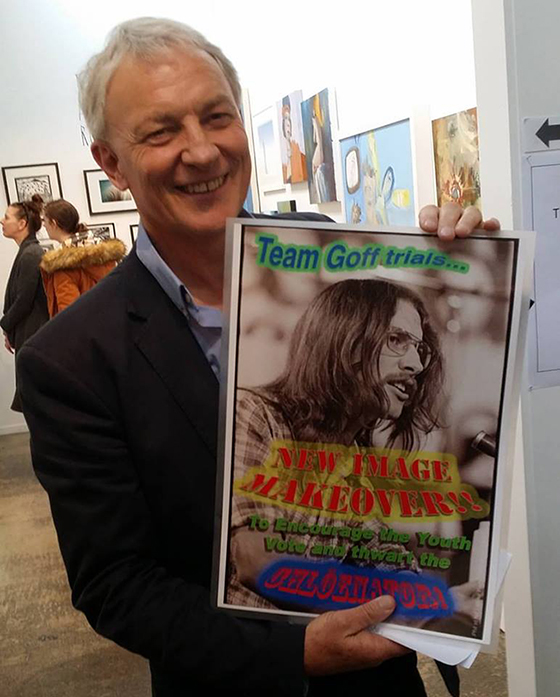 |
| Auckland mayor Phil Goff admiring a photograph by John Miller taken of the politician when he was a student activist campaigning for a nuclear-free New Zealand. Goff spoke at the “Celebrating 30 Years of Nuclear-Free Aotearoa/New Zealand” at the Depot Artspace in Devonport today. Image” David Robie |
CONGRATULATIONS everybody for that tremendous achievement three decades ago. And thank you to WILPF and Ruth Coombes for inviting me. It was literally a David and Goliath struggle to make New Zealand nuclear-free – not just David Lange, prime minister at the time, although he was vital too.
The real “David” was the ordinary people of New Zealand who exerted extraordinary pressure on the government to deliver. The barrages of letters from citizens, constant lobbying by peace campaigners, local councils – such as right here in Devonport — declaring themselves nuclear-free, the door-knocking petitioners – and, of course, the spectacular protests.
However, in my few minutes I would like to talk about the Pacific context, as this was my background. While the New Zealand campaign and success was tremendously inspirational for the Pacific, it should not be forgotten that some small Pacific countries and communities were actually ahead of the game.
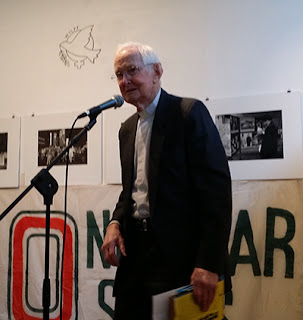 |
| Rev George Armstrong … a founder of the Peace Squadron, at the heart of the nuclear-free protests. Image: David Robie |
- 1979 – The Republic of Palau (Belau) adopted a nuclear-free constitution and was forced by the United States to hold a further 10 referenda in attempts to undermine the document. The “father” of the constitution, President Haruo Remeliik was assassinated on 30 June 1985. In the end, the people of Belau were ironically forced to vote to drop their nuclear-free status for “economic survival” a month after New Zealand’s bill became law.
- 1980 – The newly independent nation of Vanuatu, formerly the New Hebrides, also adopted a nuclear-free constitution and banned nuclear ships from its territorial waters. The country was being led by the inspirational Father Walter Lini, who linked nuclear weapons with colonialism. (He was educated St John’s Theological College right here in Auckland.)
- 1983 – Tahiti’s airport suburb of Fa’aa led by mayor Oscar Temaru, who later became president of French-occupied Polynesia several times, declared itself nuclear free.
- 1987 – The first Fiji Labour Party government led by Dr Timoci Bavadra also planned to bring in a nuclear-free law, but was deposed at gunpoint in the first military coup of Lieutenant-Colonel Sitiveni Rabuka in May that year.
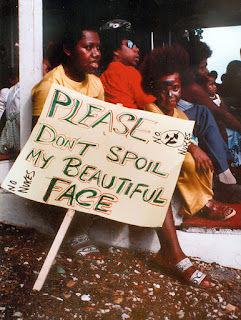 |
| 1983: One of David Robie’s photos of the mystery “no nukes” girl in Vanuatu. |
Now, I would like to tell a story about a five-year-old girl who, for me personally, was symbolic of the nuclear-free struggle.
I met her in Independence Park in Port Vila at the Nuclear-Free and Independence Movement (NFIP) conference in 1983 — just three years after Vanuatu became independent and four years before our nuclear-free law was enacted.
I didn’t know her name or anything about her then. She just had a striking appearance and I took several photos of her at the time.
She was a delightful happy painted face in the crowd that day. Yet her message was haunting: “No nukes: Please don’t spoil my beautiful face,” said her poster.
Although I didn’t know it at the time, she was sitting with her mother.
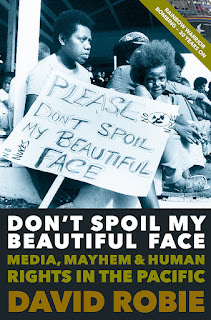 |
| 2014: The girl on the book cover … still a mystery. |
The photos in both monochrome and colour versions were published in various Pacific media and magazines over several years. All the time, questions kept tugging at me.
“Who is she? Where is she from and what is she doing now?”
Her placard slogan became the inspiration for my book in 2014, Don’t Spoil My Beautiful Face: Media, Mayhem and Human Rights in the Pacific, published by Little Island Press in New Zealand.
I would have loved to name her in the book along with the cover image of her. This spurred me onto to more determined efforts to discover her identity.
However, it seemed like a needle in a haystack mission with little prospect of success.
Social media search
First of all I posted the photo – and a Hawai’ian solidarity video that also showed the little girl, discovered by one of my student journalists – on my blog Café Pacific in October 2015. More than 1100 people viewed the blog item, but there were no tip-offs.
Then I posted it was on other blogs related to the Nuclear-Free and Independent Pacific (NFIP) movement. Again no luck.
Finally, friends at Vanuatu Daily Digest reposted my appeal on February 15 last year – and then she was identified on the southernmost island of Aneityum (“Atomic” Island, but the traditional name is “Keamu”) by people who knew her family.
Curiously, my wife Del (active in WILPF), and I were on that island at the same village, Anelgauhat, where she lives, on Christmas Day that year – and met her by chance. But we didn’t realise who she was.
 |
| 2016: June Keitadi (Warigini) … living in Anelgauhat village on Aneityum (“Atomic”) island in southern Vanuatu. |
That little girl is June Keitadi (Warigini) daughter of Annie Weitas and Jack Keitadi, then deputy curator of the Vanuatu Kaljoral Senta along with Kirk Huffman. All very active in the nuclear-free and independence movement.
Today June is assistant bursar at a local school and a Salvation Army volunteer on Aneityum. She is married, has three children and is very active in social justice issues.
My wife Del and I travelled back to this island in August last year and were welcomed to the village by June and the extended family. I have pictures on my blog about this.
A truly inspiring story.
The Pilger documentary
Just last year, John Pilger’s latest documentary, The Coming War on China, was premiered on RT Television and was shown recently in selected NZ cinemas with a short season. Pilger made several striking points in this film.
Among them was a reality check about the disputed Spratly Islands in the South China Sea – and China apparently establishing a base there – which recently became a flashpoint for global tension. News media exhaustively covered the situation.
What hasn’t been covered much, as revealed by Pilger, is the fact that China is encircled by US bases with a host of missiles pointing towards this country.John Pilger also gave a compelling account of the cultural, economic and health devastation inflicted by the post-war nuclear tests in the Republic of the Marshall Islands – then part of a United Nations trusteeship.
With test sites at sea, in the air, on reefs and underwater, says Pilger, the “total yield of the nuclear experiments on and around the Marshall Islands was equal to 7200 Hiroshima bombs, meaning the equivalent of more than one Hiroshima bomb was exploded in the area every day for 12 years.”
Bikini Island and other atolls in the Marshall Islands are still today unfit for human life.
Pilger also gave a compelling update on the fate of the people of Rongelap who were evacuated by the original Rainbow Warrior in May 1985 on the voyage leading up to the bombing here in Auckland just two months later.
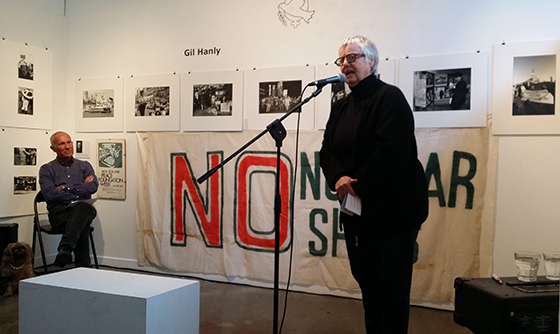 |
| Bev Cormack, deputy director of Greenpeace Aotearoa in the 1980s, speaking at the 30 years nuclear-free event in Devonport. Image: David Robie |
I was on board the “RDub” for this last voyage and my book Eyes of Fire and a TVNZ video based on my Rongelap exhibition photographs, Nuclear Exodus, tell the story. Sadly, the French spy drama at the time overshadowed the humanitarian voyage to the Marshall Islands.
It also overshadowed the shameful acts of the French politicians and military figures in the defence of colonialism – such as the assassination of schoolteacher leader of the Kanak independence movement, Eloï Machoro, in 1985 and the Ouvéa cave massacre of 19 young Kanak students and militants on 5 May 1988, less than a year after our nuclear-free law came into force.
The John Pilger documentary has brought home to us – just in case we need reminding – that the threat of nuclear war today is now the most ominous since the so-called Cold War.
I would just like to conclude my remarks by citing the preamble to the People’s Charter for a Nuclear-Free and Independent Pacific (NFIP), which says:
We, the people of the Pacific, have been victimised for too long by foreign powers. The Western imperialistic and colonial powers invaded our defenceless region, they took over our lands and subjugated our people to their whims.
This form of alien colonial, political and military domination unfortunately persists as an evil cancer in some of our native territories such as Tahiti-Polynesia, Kanaky, Australia and Aotearoa …
We … will assert ourselves and wrest control over the destiny of our nations and our environment from foreign powers, including transnational corporations.
This declaration is today just as meaningful as it was in the 1980s.We note in particular the recent racist roots of the world’s nuclear powers and we call for an end to the oppression, exploitation and subordination of the indigenous people of the Pacific.
These nuclear-free sentiments have now been revived through another struggle, the Pacific-wide movement for self-determination in West Papua.
The struggles continue …
]]>









